
Eriogonum alpinum is a species of wild buckwheat known by the common name Trinity buckwheat.
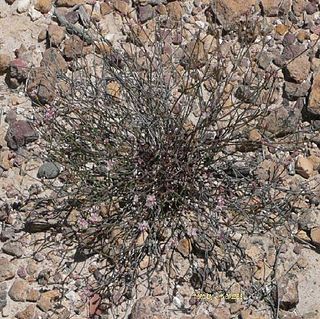
Eriogonum apricum is a rare species of wild buckwheat known by the common name Ione buckwheat. It is endemic to Amador County, California, in the United States.

Eriogonum arborescens is a species of wild buckwheat known by the common name Santa Cruz Island buckwheat.
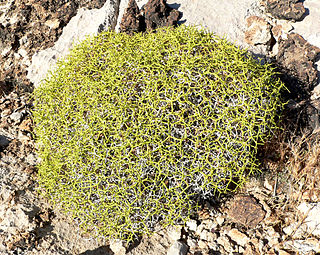
Eriogonum heermannii is a species of wild buckwheat known by the common name Heermann's buckwheat. It is native to the southwestern United States from California to Utah where it grows on rocky slopes, desert flats, and dry washes.
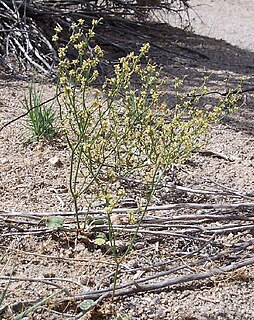
Eriogonum ampullaceum is a species of wild buckwheat known by the common name Mono buckwheat.

Eriogonum eremicola is a rare species of wild buckwheat known by the common names Telescope Peak buckwheat and Wild Rose Canyon buckwheat. It is endemic to Inyo County, California, where it is known from only a few occurrences in the Inyo Mountains and Telescope Peak in Death Valley. It grows in sandy to rocky habitat in the forests and woodlands of these desert mountains. It is an annual herb producing a spreading, glandular, reddish green stem up to about 25 centimeters tall. The rounded, woolly leaves are up to about 2.5 centimeters long and are located at the base of the stem. The scattered inflorescences are small clusters of tiny flowers which are white with reddish stripes, aging to solid red, or sometimes yellow. The plant is under protection in Death Valley National Park.
Eriogonum rixfordii is an uncommon species of wild buckwheat known by the common name pagoda buckwheat. It is native to the Mojave Desert, where it grows in California's Death Valley and adjacent parts of Nevada.

Eriogonum callistum is a rare species of wild buckwheat, known by the common name Tehachapi buckwheat.
Eriogonum cedrorum is a rare species of wild buckwheat known by the common name The Cedars buckwheat. It is endemic to Sonoma County, California where it is known only from The Cedars, an unincorporated area outside of Guerneville near Cazadero.
Eriogonum evanidum is a rare species of wild buckwheat known by the common name vanishing wild buckwheat. It is native to southern California and Baja California, where it has been collected from widely scattered areas. Most historical occurrences are now extirpated and the plant has not been collected since 1967. Some sources suggest that it is probably extinct. The plant was described as a new species in 2004 using specimens that were set aside from a collection of Eriogonum foliosum on the basis of some morphological characteristics. The specimens came from several locations in the southern California mountains, including Bear Valley in the San Bernardino Mountains and Pine Valley east of San Diego.
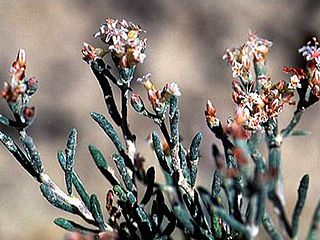
Eriogonum pelinophilum is a rare species of wild buckwheat known by the common name clay-loving wild buckwheat. It is endemic to the state of Colorado in the United States, where it is known from only two counties. The most recent estimates available suggest there are 12 occurrences in existence for a total of about 278,000 individual plants in Delta and Montrose Counties. At least 7 occurrences observed in the past have not been relocated but are not yet believed extirpated. This plant is federally listed as an endangered species of the United States.
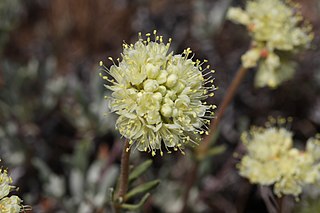
Eriogonum douglasii is a species of wild buckwheat known by the common name Douglas' buckwheat. It is native to the western United States, including the Pacific Northwest and part of the Great Basin.

Eriogonum argophyllum is a species of wild buckwheat known by the common names Sulphur Hot Springs buckwheat, Silver Lake buckwheat, and Ruby Valley buckwheat. It is endemic to Nevada in the United States, where there is only one known population.
Eriogonum codium is a species of wild buckwheat known by the common names basalt desert buckwheat and Umtanum Desert wild buckwheat. It is endemic to Washington in the United States, where it is known only from Hanford Reach National Monument in Benton County. It was discovered in 1995 during an inventory of the biodiversity of the monument and described to science in 1997.
Eriogonum diatomaceum is a species of wild buckwheat known by the common name Churchill Narrows buckwheat. It is endemic to Nevada in the United States, where it is known only from the Pine Nut Mountains in Lyon County. It is limited to the Churchill Narrows near Fort Churchill State Historic Park. This plant was discovered in 1997 and described to science in 2002.

Eriogonum visheri is a species of wild buckwheat known by the common names Dakota wild buckwheat and Visher's buckwheat. It is native to the Great Plains in the United States, where it is known from North Dakota, South Dakota, and Montana.

Eriogonum niveum is a species of flowering plant in the buckwheat family known by the common name snow buckwheat. It is native to the Pacific Northwest of North America, where it occurs in British Columbia, Washington, Oregon, and Idaho.
Eriogonum brandegeei is a species of flowering plant in the buckwheat family known by the common name Brandegee's buckwheat. It is endemic to Colorado in the United States, where it occurs in Fremont and Chaffee Counties.

Eriogonum thymoides is an "abundant" species of flowering plant in the buckwheat family known by the common name thymeleaf wild buckwheat, or simply thymeleaf buckwheat.

Eriogonum soredium is a species of wild buckwheat known by the common name Frisco buckwheat. It is endemic to Utah in the United States, where it is known only from Beaver County. There are four populations, all located in the San Francisco Mountains. It is a candidate for federal protection.















